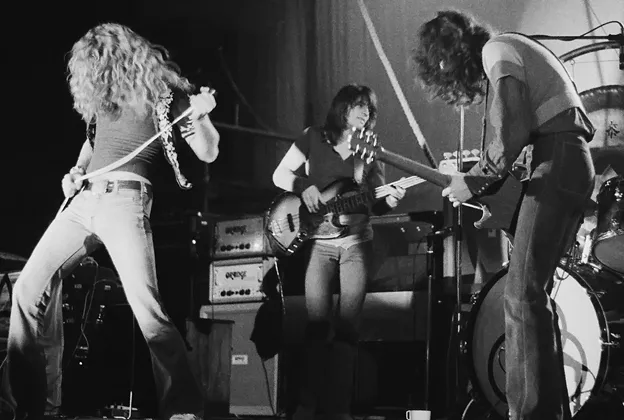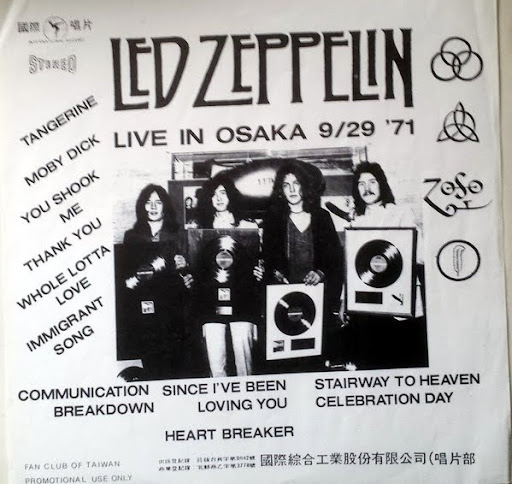
First Anniversary
Published on Dec 17, 2025
Introducing: The IHTOV Zine
Published on Dec 15, 2025
Christmas Music Selections
Published on Dec 14, 2025
The Beastie Boys and Me
Published on Dec 10, 2025
More Liner Notes…
Featured Essay: Confessions of a Former Led Zeppelin Vinyl Bootleg Addict
by Paul Prescott

Led Zeppelin was the first band that I really connected with. Thanks to “Hard Rock” FM radio of the late 1970s, I was provided with a steady dose of Led Zeppelin and all the other staples of the era. This was also the time that I started performing odd jobs so that I could afford to finally buy their albums. Once I had their full discography, the album I listened to most was the live album The Song Remains the Same. As much as I enjoyed their studio albums, to me, the live versions contained much more energy and excitement, even if they were a little rough around the edges.
Growing up in suburban southeastern Connecticut, the major record stores were in the local malls, where you were guaranteed to find a decent selection of the major artists, but not much else. It was only by chance that I happened into a small independent record store a few towns over. I always looked through the Led Zeppelin section in a record store on the off chance that there would be something new. In the pre-internet days, finding out about a new album usually meant seeing it in the record store.
What I found stopped me dead. There were twenty or so Led Zeppelin vinyl albums I had never seen ever before. They had weird titles like, Bonzo’s Birthday Party, My Brain Hurts, Live on Blueberry Hill, and the confusing Melancholy Danish Pageboys Get It On. Many just had photo-copied inserts and east Asian lettering. I asked the older man working there what these albums were.
“They’re bootlegs. Usually recorded from the crowd.”
I was intrigued. “How’s the quality?” I asked.
“Ehhh… usually decent,” was his surprisingly honest reply.
That was enough for me. It was then that I noticed the price. Single albums went for $10-20 depending on the quality of the packaging, while double albums were $20-30. Way more than the standard album price of $7-8. Still I was intrigued, I only had about $25 on me, so I figured I’d get one album to see how it was.
I looked through all the options, comparing the packaging and track listings. I knew that The Song Remains the Same came from their 1973 tour, so I stayed away from shows from that year. I opted for a double album titled Live in Osaka 9/29 ‘71. Here is the cover as I remember it:

In hindsight, I couldn’t have picked a better album. As I came to learn, there are some really bad quality bootlegs out there. This one is one of the better ones. I have since learned that there are multiple legends regarding this recording. One is that this came from some of the tracks from the professional multitrack recording that was made of this show. Plant’s vocals are somewhat buried in the mix so the theory is that this version does not include the vocal channel, and that all that is heard is bleed-through. Another theory is that the concert promoter put his recording device on the stage near the drum riser, which would explain why it also picks up the onstage banter from the drummer John “Bonzo” Bohnam.
The recording starts out with Bonham yelling, “…louder, louder!” before the band launches into “Immigrant Song.” The sound of the guitar and cymbals completely overwhelms the recording device and the recording is gloriously distorted. Once Robert Plant’s wail comes in over the top, I knew I had found my own personal Valhalla.
“The Immigrant Song” leads directly into “Heartbreaker” which features a guitar break that is far longer, and far better than it has any right to be. Side one ends with a wonderful “Since I’ve Been Loving You” with John Paul Jones’s organ leading the way. I remember being amazed at hearing the snare drum springs resonating in sympathy with Jimmy Page’s guitar during the breakdown before the ending. I prefer to believe the legend of the recording device left on the stage near the drum riser.
Side two begins with Robert Plant asking “Where’s Bonzo?” and then leading the crowd in a cheer of “Mr. Bonham!” Apparently Mr. Bonham was feeling sick and had wandered offstage. The remaining members play an acoustic version of “Tangerine.” Afterwards, Plant can be heard off mic saying, apparently to Bonham, “Where were you man?”
As Plant starts to introduce Bohnam’s signature song “Moby Dick,” Bonham can be heard saying, “I don’t wanna play this.” Regardless he turns in a fine twenty minute drum solo, although the vinyl had it shortened down to fourteen minutes. This version is unique in that Bonham incorporates some marching passages amongst the usual drum-solo fare.
Side three contains fine versions of “Stairway to Heaven” and “Celebration Day,” albeit not far removed from what appears on The Song Remains the Same. The audience response to “Stairway…” is somewhat muted because this show was about a month before Led Zeppelin IV was released.
Side four fades in mid-song as they start into “You Shook Me.” This leads into the ending of “Whole Lotta Love.” As I was later to learn, this was part of an extensive thirty-six minute long medley that included “Twist and Shout,” “Fortune Teller,” and “Good Times, Bad Times.” As some Zeppelin songs would eventually push to 30-40 minutes (“Dazed and Confused,” “No Quarter”) the vinyl format often truncated or at best, spread the songs over two sides of vinyl. It wasn’t until the advent of bootleg CDs and eventually online file sharing, that full performances started to become readily available.
A funky eight-minute “Communication Breakdown” follows. The side ends with a lengthy organ improvisation that leads into “Thank you.” Bonzo gives out a full-throated yell as he bashes the drum lead-in. Alas the song fades out about half way through the song, resulting in a subtle ending to this otherwise bombastic performance.
For the remaining two years of high school, I would make the fifteen-mile weekly pilgrimage to this record store to purchase more Zeppelin bootleg albums. For a while, it was all I was spending my meager earnings on. As the album covers were often incorrect in terms of what songs were actually on the album, I created my own file card database. I then copied that to a notebook that I could take with me when looking at prospective purchases. I learned to note the etchings in the runout grooves so that I could see if a new title was just using the stampers from a previous bootleg. By the time I left for college I had well over 100 bootleg Zeppelin albums. The store started putting aside new titles for me and consulting me on pricing for new bootlegs.
When I went off to college in 1986, I was still firmly in the hard rock camp. However, change was in the air. MTV had exposed me to new wave bands like Ultravox, Duran Duran, Bronski Beat, Talking Heads, etc, all of which would never get any play on commercial hard rock radio. Plus, I had since discovered the local Connecticut College radio station (WCNI) which was exposing me to punk and underground bands like Dead Kennedys, Hüsker Dü, Violent Femmes, X, and the Jam. Suddenly I was faced with lyrics that spoke to me about my life and the world around me, rather than the dated references to sex, hobbits, or the general vagueness that make up most of Zeppelin’s lyrics. It’s not that Zeppelin’s lyrics are bad, but they are of their time, and not of mine.
In college I quickly learned about the Smiths, Cure, New Order, and my interest in Zeppelin and hard rock in general started to wane. I still enjoyed the music, but no Zeppelin song could ever hit me as hard as the Cure’s Pornography album, or Morrissey’s wry observations on life.
This was also the start of the age of the Compact Disc (CD). Once I saw that bootlegs were starting to appear on CD, I recognized that it was time for me to move on. I asked the record store if they would be interested in buying my collection. I ended up getting far more money than I had expected, probably even turning a slight profit over what I had initially paid for them. I used that money to pay for a year of college (state school) and ended up not having to take out any student loans that year.
For the next twenty years, Led Zeppelin would just be an occasional listen for me. I picked up a few of my favorite shows on CD, but by then my tastes had expanded into industrial, free jazz, and noise. I do credit Page with starting my interest in noise from his lengthy Spinal Tap-esque guitar solos; the ones from the 1977 tour would certainly fit on Lou Reed’s Metal Machine Music.
As I entered my mid-forties, I started to find myself once again wanting to hear more Zeppelin live music. Thanks to online file sharing, just about every live recording was readily available. Also, better quality recordings have surfaced. Back in the ’80s there were no decent quality recordings from Zeppelin’s 1975 tour. Now there are almost twenty soundboard recordings in circulation. I can’t imagine how people sat on those recordings for over twenty-five years without sharing them.
The full version of this Osaka show has many more wonderful tidbits from John Bonham, including him saying, “I just got sick over there” to one of his bandmates, and later complaining that everyone is being “far too noisy.” This show also contains the only known live version of “Friends,” which they played to reward the crowd for their patience, while Bonham went missing.
As I move through my fifties, live Zeppelin is once again in regular rotation. It will never have the lyrical gravity of a song by the Minutemen or Kristin Hersh, but I am still able to enjoy it for what it is.
Are the 20-minute solos excessive? Of course, But like John Coltrane, if done right, they can be a thing of beauty. Even the Rollins Band occasionally went off on 20-minute jams. With the right band, it can work, and Zeppelin were talented enough that they could pull it off.
By the time I had become a fan, Zeppelin had already played their last show in the USA, so I never had the opportunity to see them live. I did see Jimmy Page as part of the Firm, and last year, saw two performances by John Paul Jones. One solo, and one with Thurston Moore. For the second show, I was right up front. As Thurston Moore took a screwdriver to his guitar, Jonesy bashed out chords on a keyboard. As I stood a mere few feet away from this spectacle of talent and noise, I couldn’t help but reflect on that first Zeppelin bootleg album, that started me out all those years ago.
Paul Prescott is a retired engineer from Maine. He is co-editor of an oral history book about Canadian punk rock band NoMeansNo: From Obscurity to Oblivion. He has also appeared in the Journal of Glaciology and publications from the Metal Powder Industries Foundation. He currently lives in Belize.

